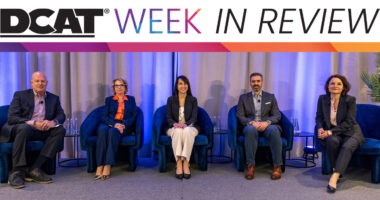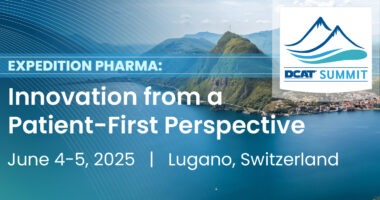Pharma CEO Scorecard: The Movers and Shakers of 2018
Refining business strategies to respond to changing market conditions is a constant in any industry, including the pharmaceutical industry. As the industry enters the final month of 2018, which pharmaceutical company CEOs have made the mark thus far in 2018 and should be the on the industry’s radar for 2019? DCAT Value Chain Insights takes an inside look.
Changing of the guard at Pfizer
Chief among the executive changes announced in 2018 is the planned succession to Ian Read, currently Chief Executive Officer (CEO) and Chairman, Pfizer, who will step down as CEO, effective January 1, 2019, with Albert Bourla, the company’s current Chief Operating Officer (COO), assuming the role of CEO. Read will transition from his current role as Chairman and CEO to Executive Chairman of Pfizer’s Board of Directors. Ian Read was named CEO of Pfizer in December 2010 and Chairman of its Board of Directors in December 2011. Pfizer subsequently announced the executive team that will report to Bourla, coincident with the commencement of his new role as CEO, effective January 1, 2019.
Read’s tenure was defined by how the company responded to the loss of key patent expiries and its subsequent moves, both organically to build its pipeline and merger and acquisitions (M&A), including the mega deals of proposed acquisitions of Allergan and AstraZeneca that did not materialize. Going forward, Bourla will be tasked with building the company’s pipeline and revenues and will face strategic decisions on the future of the company’s established products and consumer healthcare businesses.
Although completing several deals, notably the $17-billion acquisition of Hospira, a manufacturer of biosimilars and generic injectable drugs, in 2015, the $14-billion acquisition of Medivation, a company developing small-molecule oncology drugs, in 2016, and the spin-off of its animal-health business into a separate company, Zoetis, Read will be most remembered for two mega deals that did not come to fruition: a proposed $118-billion acquisition of AstraZeneca in 2014 and a proposed $160-billion acquisition of the specialty pharmaceutical company, Allergan in 2016.
Read is handing the reins to Bourla, who will be heading a newly re-organized Pfizer, which will take place at the beginning of the company’s 2019 fiscal year and positions the company as it transitions to higher growth expectations post 2020. Beginning in 2019, Pfizer will be organized into three businesses; an Innovative Medicines business, an Established Medicines business, and a Consumer Healthcare business. Read said the re-organization, which was announced earlier this year (July 2018), relates to the company’s expectations for higher growth post 2020 as the company faces significant revenue impact from the loss of market exclusivity for Lyrica (pregabalin), a drug to treat nerve pain, in the US, which is expected to occur in or after December 2018. Lyrica was Pfizer’s second top-selling drugs in 2017 with global sales of $5.065 billion.
In taking over the helm at Pfizer in 2019, Bourla will be leading the newly re-organized Pfizer but also will face several key decisions, notably for the company’s Established Medicines and Consumer Healthcare businesses. Under the new structure to take effect in 2019, the Innovative Medicines business will include the current Pfizer Innovative Health business units as well as biosimilars and a new hospital business unit for anti-infectives and sterile injectables. Pfizer will also incorporate its biosimilar portfolio into its Oncology and Inflammation & Immunology business units. Pfizer is currently organized into two main business: Innovative Health, which as the name implies includes the company’s innovator-based drugs, vaccines, and consumer healthcare segments and its Essential Health segment, which includes its legacy products (i.e., products late in the product life-cycle, generics, and biosimilars).
Another factor to consider in Pfizer’s reorganization is whether the establishment of an Established Medicines business unit, which includes products late in their product lifecycle and soon-to-lose patent protection or products that have lost patent protection, may portend the eventual separation of that business. The placement of Pfizer’s biosimilars business, which the company enhanced through its $17-billion acquisition of Hospira in 2015, to its Innovative Health business in the new reorganization, is consistent with Pfizer’s stated research and development (R&D) priorities but also would remove that piece from its Established Medicines unit. Under the new reorganization, Pfizer said the Established Medicines Unit will operate as a stand-alone entity with dedicated manufacturing, marketing, regulatory, and other enabling functions. In 2017, Pfizer recorded sales of $1 billion or more for only one product in its Essential Health business: Lipitor (atorvastatin), an anti-cholesterol drug, which posted 2017 revenues of $1.9 billion and which accounted for 9% of the Essential Health’s revenues in 2017. Pfizer decided not to separate its Essential Health business several years ago, and the question going forward is whether Pfizer will follow a similar path for its Established Medicines business unit or may decide on strategic alternatives for the business.
The spinout of its Consumer Healthcare business from its Innovative Health Segment into a stand-alone business is consistent with Pfizer’s previously announced plans to evaluate strategic alternatives for the business. In October 2017, Pfizer announced that it was reviewing strategic alternatives for its Consumer Healthcare business. It said that a range of options will be considered, including a full or partial separation of the Consumer Healthcare business from Pfizer through a spinoff, sale, or other transaction, or that it ultimately determines to retain the business.
Takeda’s big play: its pending $62-billion acquisition of Shire
Christophe Weber, CEO, Takeda Pharmaceutical, is making a large move with Takeda’s pending $62-billion acquisition of Shire. Takeda’s deal to acquire UK-based Shire is the biggest overseas acquisition by a Japanese company and also one of the most indebted, with Takeda having secured $30.9 billion in bank loans to finance the deal.
The deal has received approval from US and European regulatory authorities (conditioned on some product divestments required by the European Commission) and Takeda shareholders (88% voted in favor of deal in vote in early December 2018). The acquisition remains subject to approval by Shire shareholders at meetings expected to be held on December 5, and to the sanctioning of the Shire scheme of arrangement by a hearing of the Jersey Court (Jersey is a UK Crown dependency in which Shire is registered) that is expected to be held on January 3, 2019. Subject to receipt of the necessary Shire shareholder approvals and the sanction of the scheme of arrangement by the Jersey Court, it is expected that completion of the acquisition will take place on January 8, 2019.
The acquisition of Shire would strengthen Takeda’s position in markets outside of Japan, provide it with a specialist in rare-diseases and plasma-derived therapeutics, and complement its positions in gastroenterology and neuroscience while keeping oncology as a key therapeutic focus for Takeda, a position strengthened through Takeda’s $5.1-billion acquisition of Ariad Pharmaceuticals in 2017.
The proposed acquisition of Shire by Takeda comes two years after Shire’s $32-billion acquisition of Baxalta, the biopharmaceutical company spun off from Baxter Healthcare. In 2017, Shire recorded total revenues of $15.2 billion, which included product sales of $14.4 billion ($7.4 billion from Shire products and $7.0 billion from Baxalta products). Immunology is Shire’s largest therapy area with 2017 revenues of $4.370 billion and is one of five therapeutic franchises with sales in excess of $1 billion. Hematology ($3.786 billion), neuroscience ($2.664 billion), internal medicine ($1.670 billion), and genetic diseases ($1.438 billion) are the others.
Bayer’s life-sciences strategy and pharmaceuticals
Bayer’s $63-billion acquisition of Monsanto, an agrochemical and seed company, in June 2018 is not a pharmaceutical merger but is a significant move for Werner Baumann, who became chairman of the board of management of Bayer AG in May 2016 and who continued a strategic decision to make life sciences the focus of Bayer.
The move fortified Bayer’s strategy of being a pure-play life-sciences company with a focus on pharmaceuticals, crop protection and consumer healthcare. The deal was significant in that it places a huge investment into Bayer’s crop-protection business, not its pharmaceuticals business, which was the largest revenue piece for Bayer in 2017. Following the acquisition and taking into account certain divestments required of Bayer to complete the regulatory approval of the deal, Bayer’s health and agriculture businesses will have total pro forma sales of around EUR 45 billion ($53 billion), including combined sales of the crop-science business of around EUR 20 billion ($23 billion). With the acquisition of Monsanto, Bayer’s crop-sciences business will be the largest piece of Bayer by sales, surpassing its pharmaceutical business, which accounted for nearly 50% of the company’s sales in 2017. In 2017, Bayer had total sales of EUR 35.015 billion ($41.180 billion) with pharmaceuticals accounting for EUR 16.847 billion ($19.842 billion) or 48% of sales. Sales of the crop-science business were EUR 9.577 billion ($11.250 billion), and sales of its consumer-healthcare business were EUR 5.862 billion ($6.887 billion). Sales of its animal-health business were EUR 1.571 billion ($1.848 billion).
Last month (November 2018), Bayer announced staff reductions of approximately 10% of its global workforce, or 12,000 employees, across all of its business by the end of 2021. Approximately half of these cuts are in corporate functions, supporting functions, and business services, one-third in its crop-protection business, and about 10% in its pharmaceutical business. Bayer says its planned efficiency and structural measures are expected to enhance competitiveness and generate annual contributions of EUR 2.6 billion ($2.9 billion) as of 2022, which include expected synergies from its $63-billion acquisition of Monsanto. The restructuring also involves plans to divest its animal-health business and sell several consumer health brands.
Novartis under its new CEO
This year (2018) also saw a changing of the guard at Novartis, when Vasant Narasimhan, MD, took the helm of Novartis on February 1, 2018, assuming the role of CEO following the retirement of former CEO Joseph Jimenez. Narasimhan took the reins at Novartis following his role as global head of drug development and chief medical officer at Novartis. He became global head of drug development and chief medical officer at Novartis in February 2016 and took the lead role in the newly formed Global Drug Development organization, where he was responsible for overseeing drug development across the company’s innovative medicines and biosimilars portfolio. Jimenez, who had been CEO of Novartis since 2010, stepped down as CEO, effective January 31, 2018 and supported the transition until he officially retired on August 31, 2018.
Narasimhan took over at a significant juncture for Novartis as the company faced relatively flat sales, in part due to generic-drug competition for one of its top-selling products, the anti-cancer therapy, Gleevec/Glivec (imatinib), and other products and as it decides a new strategic path for Alcon, its eye-care division. In July (2018), Novartis announced that it plans to spin off Alcon, its eye-care division, into a stand-alone company. When the Alcon spinoff is completed, it would create a new Switzerland-based company with more than 20,000 employees with approximately $7 billion in 2017 sales. Fort Worth, Texas will continue to be a key location for Alcon. The company said that actions started earlier this year to make Alcon an operationally autonomous medical-devices business will continue in preparation for a spin-off, which is subject to Novartis shareholder approval and Board endorsement at the company’s annual meeting in 2019.
Narasimhan also took the decision on the company’s US generics business, and the company announced in September (2018) that it had agreed to sell select portions of its Sandoz US portfolio, specifically the Sandoz US dermatology business and generic US oral solids portfolio, to Aurobindo Pharma USA for $1 billion, consisting of $900 million in cash plus $100 million of potential earn-outs. Novartis says the transaction supports the Sandoz strategy of focusing on complex generics, value-added medicines, and biosimilars in order to achieve sustainable and profitable growth in the US over the long-term. The deal is expected to close in 2019 following satisfaction of customary closing conditions.
But the real test for Narasimhan is bolstering the company’s pharmaceutical business. Novartis consists of three divisions: Innovative Medicines (its prescription-drug business), Sandoz (its generics and biosimilars business), and Alcon (its eye-care division). In moving to the CEO position, Narasimhan inherited a company that had relatively flat sales in its mainstay pharmaceutical business in 2017.
In 2017, Novartis reported overall net sales of $49.1 billion, up only 1% (+2% cc), and Innovative Medicines, which accounted for 67% of the company’s 2017 revenues, delivered net sales of $33.0 billion (+1%, +2% cc) in the full year 2017, which included $2.1 billion from Cosentyx (secukinumab), a drug to treat psoriasis, ankylosing spondylitis, and psoriatic arthritis, and $507 million from Entresto (sacubitril/valsartan), a drug to treat heart failure. Both drugs, approved by the US Food and Drug Administration in 2015, are key current and future performers for the company as it faces generic-drug competition for key products. Chief among them is Gleevec/Glivec (imatinib), a drug to treat a certain form of leukemia and certain types of gastrointestinal stromal tumors. Gleevec/Gilvec was the company’s top-selling drug in 2016 with sales of $3.3 billion, but sales declined 42% in 2017 to $1.9 billion due to generic-drug competition. In 2017, Gilenya (fingolimod), a drug for treating relapsing forms of multiple sclerosis, was the company’s top-selling drug with 2017 sales of nearly $3.2 billon followed by Cosentyx (secukinumab), which reached blockbuster status in 2016 with sales of $1.1 billion and which had sales of nearly $2.1 billion in 2017.
Teva’s restructuring and its new CEO
The key test for Teva is whether its executive team can improve growth to the company following a restructuring plan in 2017 that continued into 2018. Price erosion and increased product competition in the US generics market was a key factor behind a two-year restructuring plan, announced by Teva in December 2017, which included a reduction of 25% of its workforce or 14,000 positions globally, closures or divestments of research and development facilities and offices, and a $3-billion reduction in its annual costs. This news followed an announcement by Teva in November 2017 of a new organizational structure and executive management team, which followed the appointment of a new president and CEO, Kåre Schultz, who took over on November 1, 2017. Teva had earlier announced a restructuring plan in August 2017, which included the closing or divestment of 15 manufacturing plants.
In 2017, Teva, which holds the number one position in the US generics market on a volume basis, said it was impacted by significant deterioration in the US generics market and economic environment and reported goodwill impairments of $17.1 billion in 2017, mainly with respect to its US generics reporting unit. It also faced substantial debt, which was $32.5 billion as of December 31, 2017, in large part to its $40.5-billion acquisition of Allergan’s generic business in 2016. Increased generic competition for its lead specialty medicine, Copaxone (glatiramer acetate) for treating multiple sclerosis, also contributed negatively to its performance in 2017. In addition to its restructuring plan, Teva announced that the company is conducting a “substantial optimization” of its generics portfolio globally, and most specifically in the US, through a more tailored approach to the portfolio with increased focus on profitability with a focus on complex generics and other high-barrier products.
Mylan, another challenge in generics, for CEO
Like other companies in generics, Mylan CEO Heather Bresch is facing challenges in the US generics market and is evaluating the company’s position in the US generics market. In August 2018, the company formed a strategic review committee to evaluate alternatives for its businesses following weak second-quarter performance in its North American segment. Mylan says the profile of the company has changed over the last several years by shifting its core from a US-centric operation to an international presence.
“Our international business, in which we expect continued growth, now represents more than 60% of the company’s global sales,” Mylan said in an August 8, 2018 company statement. “These global growth expectations are in contrast to the negative trends and dynamics playing out in the US marketplace, which we believe are unsustainable for the healthcare system over the long-term but which we believe Mylan is uniquely well positioned to successfully weather and navigate.”
“The formation of this strategic review committee followed the release of Mylan’s second-quarter 2018 results, in which the company reported revenues of $2.81 billion, down 5% compared to the prior year period. The company reported North America segment net sales of $1 billion, down 22% compared to the year-ago period. The company reported Europe segment net sales of $990.6 million, up 4% and rest of world segment net sales of $764.1 million, up 10%.
“Our Europe and Rest of World segments continue to deliver growth in line with our expectations. However, our efforts to serve patients in the US have been shaped by the industry’s transformation there, and our results and guidance for 2018 are directly correlated with the ongoing rebasing of the US healthcare environment,” said Mylan CEO Heather Bresch, in the company’s August 8, 2019 earnings statement. Mylan noted the board has not set a timetable for its evaluation of alternatives and there can be no assurance that any alternative will be implemented.
Merck & Co. stays the course
Merck & Co. affirmed its course and executive leadership for 2019 when earlier this year (September 2018), the company announced that Kenneth C. Frazier, Chairman and CEO agreed to remain in his position beyond December 2019, when he turns 65. The company’s Board of Directors rescinded its policy subjecting the company’s CEO to mandatory retirement at age 65 to allow Frazier to continue.
Frazier has been CEO of Merck & Co. since 2011. In 2017, the company posted revenues of $40.1 billion, up 1% from 2016. The company had several blockbusters (defined as drugs with sales of $1 billion or more) in 2017: Keytruda (pembrolizumab), the company’s immuno-oncology drug with 2017 sales of $3.8 billion and the company’s top-selling drug; its anti-diabetes drugs Januvia (sitagliptin), which had 2017 sales of $3.74 billion, and Janumet (sitagliptin and metformin) a fixed-dose combination with 2017 sales of $2.16 billion; Gardasil/Gardasil (human papillomavirus 9-valent vaccine, recombinant), a vaccine for cervical cancer with 2017 sales of $2.31 billion; ProQuad/M-M-R II /Varivax, a measles, mumps, and rubella virus vaccine with 2017 sales of $1.68 billion; and Zepatier (elbasvir/grazoprevir), a drug for treating hepatitis C with 2017 sales of $1.66 billion.
New executive team at Gilead
Earlier this year (July 2018), Gilead Sciences announced that John F. Milligan, PhD, President and CEO, and John C. Martin, PhD, Chairman, will step down from their roles. Milligan is remaining in his current position through the end of the year (2018) while Gilead’s Board of Directors conducts a search to identify a successor. He will also step down from the Gilead Board of Directors at the end of the year. Additionally, Martin has announced his intent to step down from the board at the time a new CEO joins the company.
The executives have been part of Gilead’s rise, lead by its hepatitis C franchise, but most recently have also been part of declining sales in that product franchise. Gilead’s Sovaldi (sofosbuvir), the first oral treatment for hepatitis C, was approved by the US Food and Drug Administration in late 2013, and it became the company’s top-selling drug in 2014 with sales of $10.3 billion, contributing to more than a doubling of the company’s product revenues in 2014 from $10.8 billion in 2013 to $24.5 billion in 2014. A follow-up hepatitis C drug, Harvoni (ledipasvir/sofosbuvir), which was approved in 2014, eventually surpassed Sovaldi in sales, but both drugs have faced declining sales. In 2017, Harvoni had sales of $4.37 billion, down from 2016 sales of $9.08 billion, and Sovaldi had 2017 sales of $964 million, down from 2016 sales of $4.0 billion.
Going forward, Gilead is placing bets on new product areas, notably gene and cell therapies. In October 2017, Gilead Sciences completed its acquisition of Kite Pharma, a company developing cell and gene therapies, for approximately $11.9 billion. With the acquisition, Gilead gained Yescarta (axicabtagene ciloleucel), a chimeric antigen receptor T cell (CAR-T) therapy, from Kite Pharma, a for treating adult patients with certain types of large B-cell lymphoma. Yescarta was the second CART-T therapy approved by the FDA and is slated by some analysts for blockbuster status.






